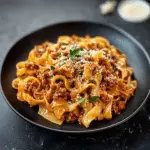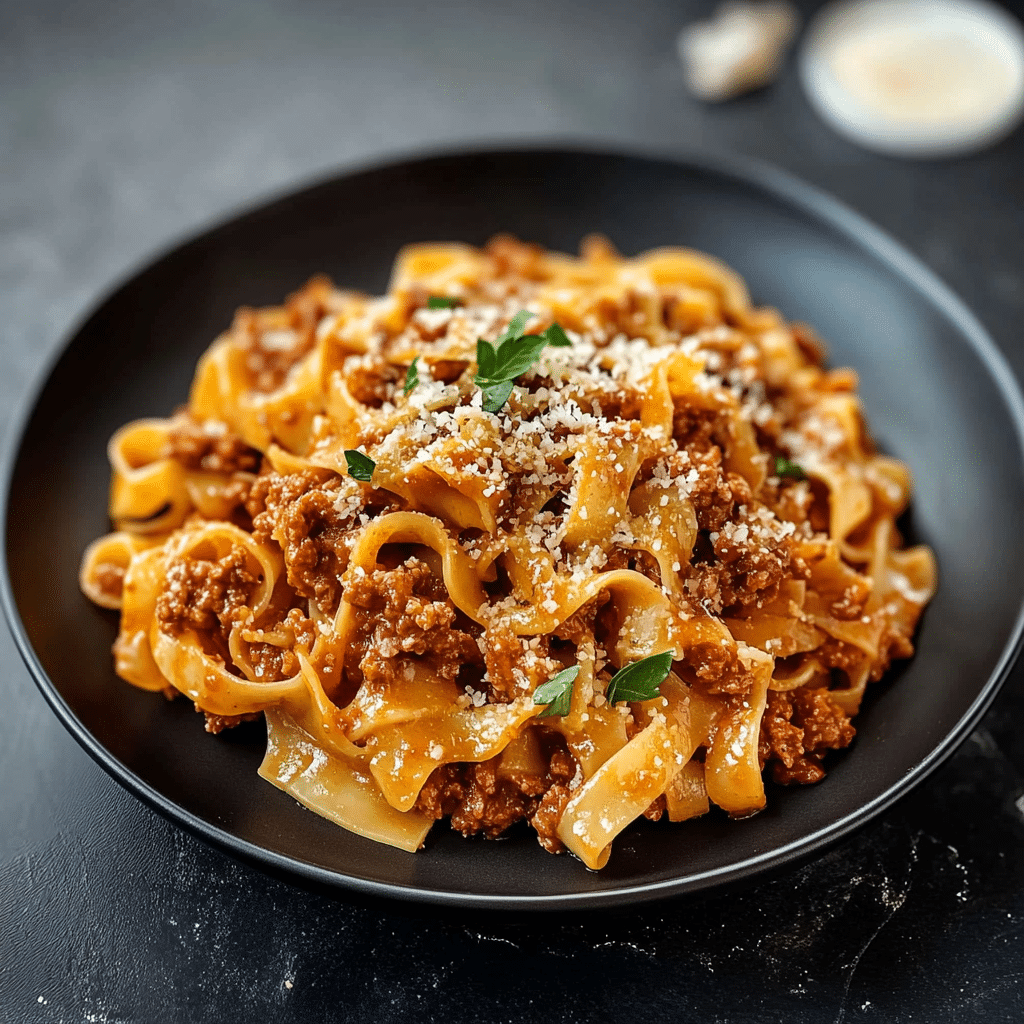If you’re in the mood for something different yet comforting, Korean Bulgogi Bolognese is the perfect dish to try. This innovative fusion recipe combines the bold, smoky flavors of traditional Korean bulgogi with the savory depth of classic Italian Bolognese sauce. It’s a delightful blend of sweet, salty, and umami notes that will tantalize your taste buds and keep you coming back for more. Ground beef is cooked slowly with a medley of vegetables, soy sauce, ginger, garlic, and scallions, creating a complex and rich sauce. The mushrooms add an earthy depth, while the egg pasta provides a perfect base to soak up all that goodness. Whether you’re hosting a dinner party or simply craving something new for the family, this dish is sure to impress. It’s a unique take on comfort food that’s just as delicious as it is exciting.
Why You’ll Love This Recipe
1. Unique Flavor Fusion
Korean Bulgogi Bolognese combines two beloved cuisines, delivering a smoky, savory sauce with an unexpected twist. The Korean bulgogi-inspired base brings in sweet, salty, and umami elements, while the Italian Bolognese delivers the comforting richness we all love.
2. Quick and Easy
With a prep time of just 20 minutes and a cooking time of 25 minutes, this recipe is simple yet delivers incredible flavors. It’s perfect for a busy weeknight dinner or a weekend gathering.
3. Rich, Layered Sauce
The sauce is simmered to perfection, slowly building flavors from the vegetables, soy sauce, garlic, and ginger. It’s rich, aromatic, and perfectly balanced, making it an unforgettable dish.
4. Versatile for All Occasions
Whether you’re preparing dinner for your family or making a dish to impress friends, this recipe fits any occasion. The combination of beef, pasta, and robust flavors makes it a guaranteed crowd-pleaser.
5. Comfort Food with a Twist
This fusion dish brings together the familiar comfort of pasta with a new and exciting flavor profile. It’s comforting yet adventurous, ideal for anyone craving something new.

Ingredients
- Finely chopped onion
- Finely chopped carrot
- Finely chopped celery
- Minced garlic
- Minced ginger
- Tomato paste
- Ground beef
- Finely chopped white button mushrooms
- Finely chopped scallions
- Low-sodium soy sauce
- Turbinado sugar
- Kosher salt and black pepper
- Dried egg pasta (tagliatelle or pappardelle)
- Safflower or canola oil
- Freshly grated Parmesan cheese
Variations
- Vegetarian Option: Substitute ground beef with plant-based meat or mushrooms to create a vegetarian version of the dish.
- Spicy Bulgogi Bolognese: Add gochujang (Korean chili paste) or red pepper flakes to introduce some heat and a more authentic Korean flavor.
- Noodle Variations: While egg pasta is recommended, you can also serve this sauce over rice, zucchini noodles, or even gluten-free pasta for different twists.
- Add Extra Veggies: Feel free to add other vegetables like bell peppers or spinach to boost the nutritional value.
How to Make the Recipe
Step 1: Prepare the Vegetables
Finely chop the onion, carrot, celery, garlic, ginger, and mushrooms. Set them aside, ready for cooking.
Step 2: Sauté the Vegetables
In a large skillet or Dutch oven, heat the safflower or canola oil over medium heat. Add the onion, carrot, and celery. Sauté for 5-7 minutes until the vegetables soften and the onion becomes translucent.
Step 3: Add Garlic and Ginger
Add the minced garlic and ginger to the pan, and cook for an additional 1-2 minutes, stirring frequently until fragrant.
Step 4: Cook the Ground Beef
Add the ground beef to the pan, breaking it up with a spoon. Cook for 6-8 minutes until the meat is browned and fully cooked.
Step 5: Stir in Mushrooms and Soy Sauce
Add the finely chopped mushrooms and soy sauce to the pan, stirring to combine. Let it cook for about 3 minutes until the mushrooms soften and release their moisture.
Step 6: Add Tomato Paste and Sugar
Stir in the tomato paste and turbinado sugar. Continue to cook for another 2 minutes to allow the sugar to dissolve and the sauce to deepen in flavor.
Step 7: Season the Sauce
Add salt and black pepper to taste. Stir well and let the sauce simmer on low heat for 10 minutes to let all the flavors meld together.
Step 8: Cook the Pasta
Meanwhile, cook the pasta in salted water according to package instructions. Drain and set aside.
Step 9: Combine Pasta and Sauce
Once the sauce is ready, toss it with the cooked pasta, ensuring the noodles are well coated with the sauce.
Step 10: Serve
Serve the Korean Bulgogi Bolognese hot, topped with freshly grated Parmesan cheese and a sprinkle of chopped scallions.
Tips for Making the Recipe
- Don’t Overcrowd the Pan: When cooking the vegetables and meat, avoid overcrowding the pan to ensure even cooking.
- Adjust Sweetness: If you prefer a sweeter sauce, add more turbinado sugar. For a more savory version, reduce the sugar slightly.
- Use Fresh Pasta: For an even richer flavor, try using fresh egg pasta instead of dried.
- Add Texture: If you like a chunkier sauce, reduce the amount of chopped mushrooms or ground beef for more texture.

How to Serve
Korean Bulgogi Bolognese is best served hot with a generous topping of freshly grated Parmesan cheese. For an added touch, garnish with chopped scallions and perhaps a dash of chili flakes for those who enjoy a little heat. Pair it with a side salad, some crusty bread, or a light vegetable dish to balance the richness of the pasta.
Make Ahead and Storage
Storing Leftovers
Leftovers can be stored in an airtight container in the refrigerator for up to 3 days. Be sure to let the dish cool completely before storing.
Freezing
To freeze, allow the dish to cool completely, then transfer it to a freezer-safe container. It will keep for up to 3 months in the freezer. To reheat, simply thaw overnight in the refrigerator and reheat in a skillet over low heat.
Reheating
Reheat leftovers gently on the stovetop or in the microwave. Add a splash of water or broth to keep the sauce from drying out.
FAQs
1. Can I use chicken instead of beef?
Yes, you can use ground chicken or turkey as a leaner alternative to beef.
2. Can I make this recipe ahead of time?
Yes, you can make the sauce ahead of time and refrigerate it. Simply reheat it before serving and cook the pasta fresh.
3. What type of pasta works best?
Tagliatelle or pappardelle works great, but you can use any wide egg pasta for the best texture.
4. How spicy is this dish?
This dish is not inherently spicy, but you can adjust the heat level by adding gochujang or red pepper flakes to your liking.
5. Can I freeze this recipe?
Yes, this recipe can be frozen for up to 3 months. Just make sure to store it in a freezer-safe container.
6. Can I make this recipe vegetarian?
Yes, simply substitute the ground beef with plant-based meat or more mushrooms for a vegetarian version.
7. Can I add more vegetables?
Feel free to add other vegetables like bell peppers or zucchini for extra flavor and nutrition.
8. How long does the sauce need to simmer?
The sauce should simmer for about 10 minutes to allow the flavors to meld and develop.
9. Can I use regular soy sauce instead of low-sodium?
Yes, but be cautious with the salt as regular soy sauce is much saltier than the low-sodium version.
10. What can I serve with Korean Bulgogi Bolognese?
A simple green salad, roasted vegetables, or crusty bread make great side dishes.

Conclusion
Korean Bulgogi Bolognese is a delicious fusion dish that brings together the bold flavors of Korean cuisine with the comforting richness of Italian pasta sauce. It’s easy to prepare, versatile, and packed with layers of flavor. Whether you’re a fan of Korean food, Italian classics, or both, this recipe will offer a unique and satisfying twist on your typical dinner routine. Enjoy it with your favorite pasta, and don’t forget the Parmesan!
Print
Korean Bulgogi Bolognese: A Fusion of Flavors
- Total Time: 45 minutes
- Yield: 6 servings 1x
Description
This recipe combines the smoky, bold flavors of Korean bulgogi with the hearty, savory essence of classic Italian Bolognese. Ground beef is simmered in a rich, layered sauce made with onions, carrots, celery, soy sauce, ginger, garlic, and scallions. The addition of mushrooms enhances the complexity of the sauce, while egg pasta serves as the perfect base for this flavorful dish.
Ingredients
- 1 cup finely chopped onion
- 1 cup finely chopped carrot
- 1 cup finely chopped celery
- 7 garlic cloves, minced
- 2 tablespoons peeled minced ginger
- 2 tablespoons tomato paste
- 1 pound ground beef
- 4 ounces white button mushrooms, finely chopped (about 2 cups)
- ¾ cup finely chopped scallions
- ¾ cup low-sodium soy sauce
- ¼ cup turbinado sugar
- Kosher salt and black pepper, to taste
- 12 ounces dried egg pasta (tagliatelle or pappardelle)
- 2 tablespoons safflower or canola oil
- Freshly grated Parmesan for serving
Instructions
- Heat oil in a large skillet or saucepan over medium heat.
- Add chopped onion, carrot, and celery. Sauté for about 5-7 minutes until softened.
- Stir in garlic and ginger, and cook for an additional 2 minutes.
- Add tomato paste and cook for 2 minutes, stirring occasionally.
- Add ground beef to the pan, breaking it apart with a spoon. Cook until browned.
- Stir in chopped mushrooms and cook until they release their moisture and become tender.
- Add soy sauce, turbinado sugar, and season with kosher salt and black pepper. Simmer for 15-20 minutes to allow the flavors to meld together.
- Meanwhile, cook the pasta according to the package instructions. Drain, reserving some of the pasta water.
- Toss the cooked pasta with the Bulgogi Bolognese sauce, adding pasta water to reach the desired consistency.
- Serve hot, topped with freshly grated Parmesan and chopped scallions for garnish.
Notes
- If you prefer a sweeter sauce, you can adjust the amount of turbinado sugar.
- You can substitute the ground beef with ground turkey or chicken for a lighter version.
- For a spicier kick, add some red pepper flakes to the sauce.
- Prep Time: 20 minutes
- Cook Time: 25 minutes
- Category: Meat, Pasta
- Method: Sautéing, Simmering
- Cuisine: Fusion (Korean-Italian)
Keywords: Korean Bulgogi, Bolognese, Fusion, Ground Beef, Pasta, Soy Sauce, Egg Pasta, Korean Flavor

